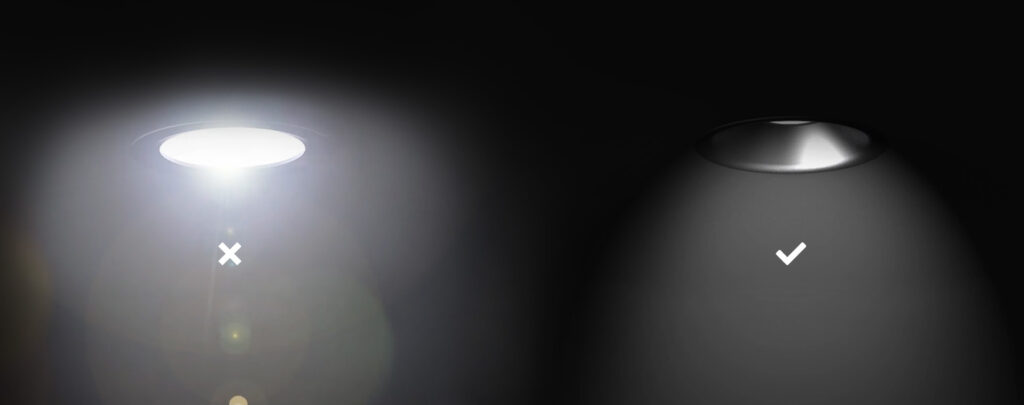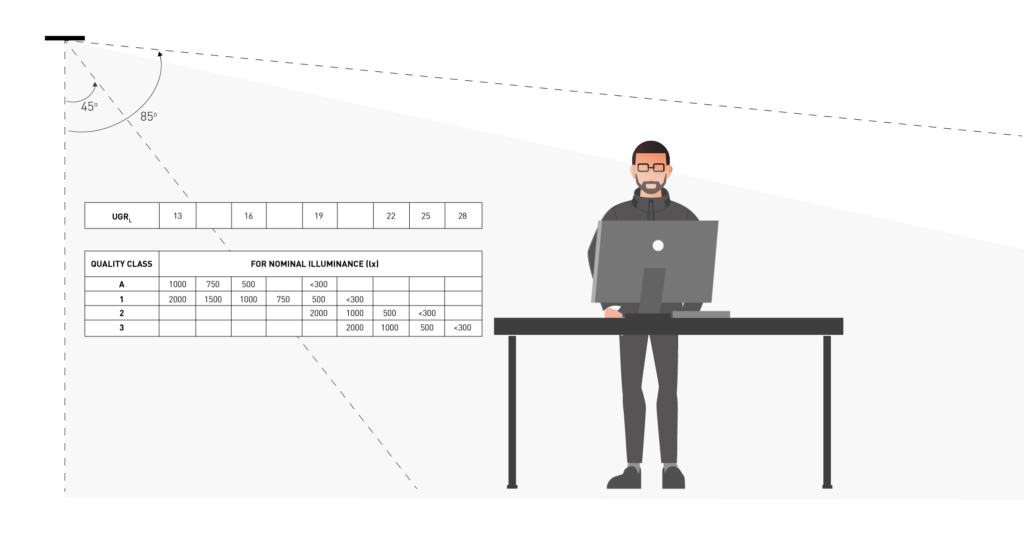
To many of you, glare is that piercing look you got from your third-grade teacher who caught you passing notes to your crush. Or perhaps that greasy scowl you get from your barista when you ask for an extra hot decaf soy mochaccino with froth on the side.
At Brightgreen, glare is our archenemy. Okay, we have a lot of nemeses: planned obsolescence, climate change, and poor lighting, among other things. But we hate glare. Like a lot. Like more than traffic jams.
And so, out of the goodness of our heart (we’re so selfless), we’ve prepared this playbook on defeating glare.
But, it’s not really a playbook because you only need to do one thing to defeat glare. Choose Brightgreen. Our lights have low-glare designs with recessed optics and ultra low-glare coatings to deliver the highest levels of visual comfort. Pair that with our lighting designs and digital simulations, and it’s a no glare-er.
So, skip the glare and the reading, and get in touch instead.
What is glare?

If you want to defeat glare, you must first uncover glare’s meaning. We think Sun Tzu said that, but don’t quote us on it.
Glare is definitely the thing the sun does to make you squint uncontrollably while driving your car. But, we should give glare some meaning. It’s a visual sensation due to intense, uncontrolled brightness.
In other words, it’s when too much light hits your eyeballs.
It’s caused by light sources—either directly or indirectly (eg, by reflective services). However, sensitivity to glare will vary from person to person. If you’re older or have vision problems, you’ll be more sensitive to glare.
Glare can cause discomfort and/or disability to the person experiencing it. And so—yes, you guessed it—there are two types of glare:
a. Disability Glare: It’s reduced visibility due to a potent light source. Imagine it as a veil over your eyes that makes it hard to see.
b. Discomfort Glare: It’s discomfort and pain due to a bright light source. It usually doesn’t result in vision impairment (when compared to disability glare).
Why does light glare matter? Why is it so terrible?
Glare is bad. Heck, we’ve gone so far as to describe it as a truly detrimental visual pollutant.
Why is light glare so terrible? Well. We know it’s associated with impaired vision and discomfort. But it’s all the other flow-on consequences that really matter:
a. It can cause accidents by decreasing safety.
b. It can affect your health and wellbeing by causing eye strain, headaches, and fatigue. And it’ll also disrupt your circadian rhythm.
c. It can reduce your productivity. And we all love productivity these days.
d. It can even detrimentally affect the environment by increasing light pollution.
All of this can be avoided, though. You’ll just need to combine world-class lighting (like ours) with an equally exceptional lighting design (like ours). Learn how.
How do you measure discomfort glare? Unified Glare Rating (UGR)

The discomfort level of glare is quantified using the Unified Glare Rating (UGR). UGR levels usually range from 10 (discreet glare) to 30 (excruciating or ‘OMG-I-Can’t-See’ glare).
Glare calculations are complex and are better solved using lighting design software. It’s an intricate formula using logarithmic functions and lots of variables, and it isn’t just about the luminaires. And for this article, we won’t delve too deeply into the nitty-gritty. But if you’re our type of lighting nerd, and you felt a frisson of excitement when you read ‘logarithmic functions’, you too can deep dive into our white paper: How to Reduce Glare for Comfortable Lighting Levels.
Simply put, the lower the UGR, the better. Keep in mind that UGR is calculated based on the complete lighting installation. In Australia, standards declare that discomfort glare occurs when the UGR is greater than 19. And for that reason, it’s recommended that all residential spaces remain below UGR 19. The best thing about Brightgreen lights? UGR < 10, babyyyy.
Read about the test here.
Reducing Glare (And Why You Need Brightgreen)

There are two ways that you can reduce or neutralise glare:
a. Go to the root of the problem, and buy products designed to account for glare.
b. Get a lighting design and lighting simulation. This will help you understand how the products perform in your space and how they interact with your furniture.
Luminaire Design
A manufacturer should implement light shielding or light cutoff when designing a light. It’s the most effective way to redirect light spill from a light source onto the intended path. You can achieve this by using a reflector or a LED lens or recessing the luminaire.
And it’s why you need Brightgreen products in your life. Take our linear downlights as an example. They’ve got recessed, interchangeable low-glare LED lens modules (with low-glare coatings) that provide excellent comfort with imperceptible average UGRs of less than 10. As we said, it’s a no glare-er.
And there are all the filters and fascias you could add to your downlights to reduce glare even further. Oh, and let’s not forget our outdoor line light collection, where the light source and optics are hidden behind baffles so that architectural surfaces are illuminated without seeing the source.
Lighting Designs
UGR is determined by how all the light sources are installed in a room and how they operate in that room (eg, reflecting off surfaces). And each space is unique. That’s obvious. Dimensions. Mounting heights. Surfaces. Furniture. It’s why lighting design is so important when trying to achieve those low UGRs.
An exceptional lighting design will guide you in selecting the right combination of LEDs and the correct mounting locations to achieve the perfect low-glare scenario. You can achieve this with indirect illumination (soft, ambient lights), skyglow, wall washing, and light layering.
The Ultimate Solution

It’s simple. It’s lighting design, digital simulation, and world-class lights. And there’s no one that does world’s highest light quality LEDs with flicker-free drivers better than Brightgreen. These are the ingredients to achieving enviable UGRs. Get in touch—we can organise the whole kit and caboodle.


